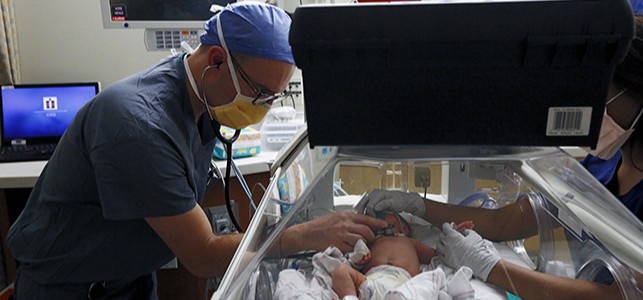
Nearly half of premature infants born between 22 and 23 weeks are born with a condition called patent ductus arteriosus that doesn’t allow them to breathe on their own. Until recently, medications and surgery were the only treatment options.
Now a tiny device offers a minimally invasive solution for even the smallest patients. Interventional cardiologist Dr. Samuel Casella explains how the device works to treat PDA.
What is patent ductus arteriosus?
When children are inside their mother's womb, they don't need to breathe. A special connection called a ductus arteriosus allows blood to pass through their developing body, bypassing the lungs. When they’re born, that bypass is supposed to close to allow them to start using their lungs and start breathing. When babies born too early and small, that connection sometimes doesn’t close as it should – a condition called a patent ductus arteriosus – which can be problematic and make breathing difficult. Approximately half of children born at 22 to 23 weeks gestation will still have a patent ductus arteriosus when they’re 2 to 3 weeks old.
What are the treatment options for PDA?
In the past, the only options for us to close a PDA were either medicines, which work about half the time, or surgery. The surgery involves cutting open the side of baby’s chest and physically tying off the ductus arteriosus. It’s a successful surgery, however it comes with risk of complications and leaves a scar on the child’s chest for the rest of their lives.
What is the newer approach to PDA treatment and how does it work?
The FDA approved a device in 2019 which enables us to close these PDAs via catheterization, which is considered minimally invasive surgery. We thread a very small catheter through a blood vessel in the groin all the way up into the heart. We release a tiny plug, which closes the hole by creating an intentional blood clot that gets rid of the PDA. We then take the catheter out and, at most, the child is left with a pinpoint scar on their groin. This procedure can be used in infants as small as 700 grams (1.5 lbs) which is small enough to fit in the palm of your hand.
How are patient outcomes after using catheterization for PDA closure?
This is a very successful procedure. The data would support a procedural success rate of somewhere around 99%. The exciting thing about it is that we can do it safely in such small infants, and this is a lifelong solution to the PDA. It gets rid of it for good, and you don't have to have any other procedures later in life.
Discover our dedicated pediatric cardiac catheterization and electrophysiology lab – the first of its kind in the region.
Learn about the care CHoR provides for every heart condition
